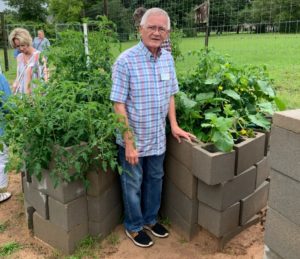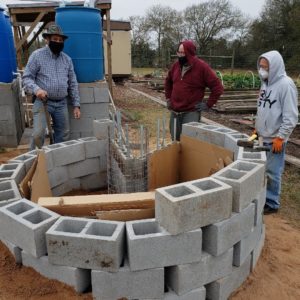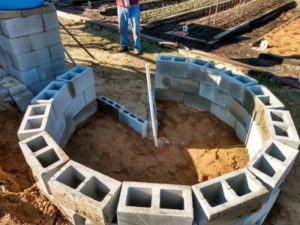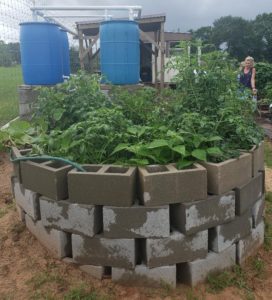By Faye Beery, Bluebonnet Master Gardener Assocaiton
That is how long the Master Gardener program has been going in our 4 county region. On May 25, 2021 the Bluebonnet Master Gardeners celebrated our 20th anniversary of the demonstration garden in Austin County. While the weather was not the best, everyone enjoyed the program given by Dr. Shackelford, good food and seeing the Bluebonnet Master Gardener Association’s demonstration garden located at the Sens Acitvity Center in Bellville, Texas. Vegetables were available, most gave a voluntary donation to the garden, as well as some produce was avaialbe to pick in the garden.
A big attraction in the garden was the keyhole garden. The keyhole concept was first introduced into arid African regions by the U.K. organization Send a Cow. The idea was to help poor families grow their own food despite the poor soil and drought conditions. The keyhole concept is a raised circular bed with a wedge shaped cutout on one side which allows persons easy access to the whole bed. When seen from above, it resembles a lock and keyhole. In the center is a wire cage for compost which decomposes and provides nutrients to the bed. This form is less labor intensive and more affordable for people who want to grow their own food. And you don’t have to bend over.
The outer structure can be any sturdy material, cinder blocks, bricks, rocks are a good choice. They are placed in a round design with a wedge on one side so that individuals can reach the middle as well as the outsides allowing for easy planting and harvesting. The wire cage in the center makes it easily accessible to place the compost materials.
A strong advocate of the keyhole concept is Deb Tolman, PhD, from Clifton, Texas. She is an environmental scientist and landscape designer and co-founder of the Silo Project a non-profit organization, which is centered on sustainability. Due to her outreach and workshops, there are more than 70 keyhole gardens in Clifton, which is in arid North Texas. She recommends a 3:1 ratio of brown and green material which forms the core garden. Decomposition rapidly generates heat and breaks down the material to feed plants. Brown material includes brown grass/leaves; paper and wood, straw, sawdust, lint from the dryer or vacuum, and lots of cardboard, which is the first layer in the bottom of the bed. It should be thoroughly wet to begin decomposition. Green materials include kitchen scraps, manure, green grass/leaves, or plants. Her website provides instructions on how to construct a keyhole garden. Follow the link to her Field Guide PDF .
There is also a new addition to the garden which is currently under construction this week. It is Pete and Paula’s pollinator patch. They plan to include plants which attract pollinators to the garden to pollinate the vegetables that grow there. We’ll have more on this when they begin planting.
I know everyone is happy to get back to our regular meetings. See you at the next one!



